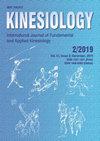Effects of a mobility and dynamic strength intervention program on the range of motion, strength, and strength asymmetry in people with neck or low back pain
IF 0.9
4区 医学
Q4 REHABILITATION
引用次数: 0
Abstract
The purpose was to ascertain the effects of a 12-week intervention program based on exercises of mobility and dynamic strength on the stabilization of neck and trunk muscles in people with neck or low back pain according to gender. Forty-two subjects (n = 25 males and n = 17 females; age 49.62±8.82 years) with neck or low back pain completed a recovery-training program focused on improving mobility and strength in the stabilizing muscles of the trunk and neck. A range of motion test, a strength (maximum voluntary contraction) test and the muscle strength asymmetry of the muscle groups analyzed were assessed at the beginning (T1), after six (T2) and after 12 (T3) weeks of intervention. Improvements were seen in nine out of the 12 range of motion variables at T2 (ES=0.52 to 1.26, moderate-high; p<.05) and T3 (ES=-0.28 to -0.44, low; p<.05 or p<.01). Improvements were also evident in all the strength variables at T2 (ES=-0.81, high; p<.01) and T3 (ES=-1.08 to -0.95, high; p<.01). In contrast, in the strength asymmetry variables improvements were found in one out of the five variables analyzed at T2 (ES=-0.81, high; p<.01) and two out of five at T3 (ES=- 1.08 to -0.95, high; p<.01). In conclusion, the intervention was effective for improving range of motion and strength. However, to improve muscle strength asymmetry it may be necessary to include specific exercises.活动和动态力量干预方案对颈部或腰痛患者的活动范围、力量和力量不对称的影响
目的是确定一个为期12周的干预计划的效果,该计划基于活动和动态力量的锻炼,对颈部和躯干肌肉稳定的影响。42名受试者(男性25名,女性17名);年龄49.62±8.82岁),颈部或下背部疼痛,完成了一个恢复训练计划,重点是提高躯干和颈部稳定肌肉的机动性和力量。在干预开始(T1)、6周(T2)和12周(T3)后评估运动范围测试、力量(最大自主收缩)测试和肌肉群的肌肉力量不对称性。在T2时,12个运动变量范围中的9个得到改善(ES=0.52至1.26,中高;p< 0.05)和T3 (ES=-0.28 ~ -0.44,低;p&肝移植;。05或p<.01)。T2时所有强度变量的改善也很明显(ES=-0.81,高;p<.01)和T3 (ES=-1.08 ~ -0.95,高;p&肝移植;. 01)。相比之下,在强度不对称变量中,在T2时分析的五个变量中有一个得到改善(ES=-0.81,高;p<.01)和2 / 5的T3 (ES=- 1.08至-0.95,高;p&肝移植;. 01)。总之,干预是有效的,以改善活动范围和力量。然而,为了改善肌肉力量不对称,可能有必要进行特定的锻炼。
本文章由计算机程序翻译,如有差异,请以英文原文为准。
求助全文
约1分钟内获得全文
求助全文
来源期刊

Kinesiology
REHABILITATION-SPORT SCIENCES
CiteScore
1.90
自引率
8.30%
发文量
16
审稿时长
>12 weeks
期刊介绍:
Kinesiology – International Journal of Fundamental and Applied Kinesiology (print ISSN 1331- 1441, online ISSN 1848-638X) publishes twice a year scientific papers and other written material from kinesiology (a scientific discipline which investigates art and science of human movement; in the meaning and scope close to the idiom “sport sciences”) and other adjacent human sciences focused on sport and exercise, primarily from anthropology (biological and cultural alike), medicine, sociology, psychology, natural sciences and mathematics applied to sport in its broadest sense, history, and others. Contributions of high scientific interest, including also results of theoretical analyses and their practical application in physical education, sport, physical recreation and kinesitherapy, are accepted for publication. The following sections define the scope of the journal: Sport and sports activities, Physical education, Recreation/leisure, Kinesiological anthropology, Training methods, Biology of sport and exercise, Sports medicine and physiology of sport, Biomechanics, History of sport and Book reviews with news.
 求助内容:
求助内容: 应助结果提醒方式:
应助结果提醒方式:


